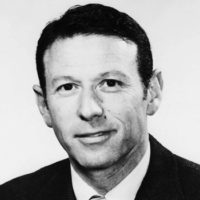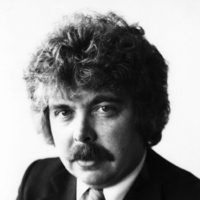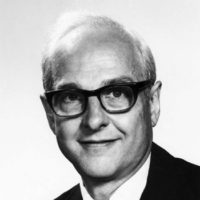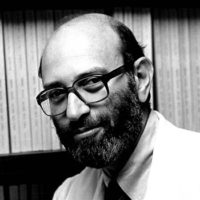
Paul Berg
Stanford University School of Medicine

Herbert W. Boyer
University of California, San Francisco

A. Dale Kaiser
Stanford University School of Medicine

Stanley N. Cohen
Stanford University School of Medicine
For historic achievements that made recombinant DNA a brilliant reality, and inaugurated a new age of biomedical promise.
Paul Berg
Paul Berg brilliantly envisioned how a portion of a DNA molecule from one cell could be woven artificially into the DNA of another, and devised a fundamental technique which has helped to make recombinant DNA a practical reality.
In 1970, Dr. Berg began research to find a method for introducing additional DNA in
to the DNA of a living cell. Two years later, Dr. Berg and his co-workers showed that the well-known SV40 virus could be used as a carrier, or "vector," for DNA fragments. Dr. Berg used enzymes to cut a hole in the viral DNA and substitute a piece of bacterial DNA.
In 1976, Dr. Berg and his student, Stephen Goff, constructed a new kind of recombinant DNA, reintroducing it into the nucleus of a cultured animal cell, where it multiplied and functioned as a viral gene. In subsequent experiments, with his student Richard Mulligan, Dr. Berg introduced a new gene into the chromosomes of cultured animal cells, where the new gene functioned as if it were part of the cellular chromosomes, showing that artificially reconstructed DNA can cause changes in the biological activity of an animal cell.
Recombinant DNA will shape many vital industrial processes, from the preparation of vaccines to the creation of new sources of energy. It has already been used to establish new supplies of medically important natural substances such as human hormones and interferons.
Even more exciting, scientifically, is the prospect of learning, through recombinant DNA methodology, how human chromosomes are structured, and how genes really work. Dr. Berg's discoveries are helping scientists to clarify our understanding of development and differentiation of all living things. Recombinant DNA may reveal how the incalculable latent powers of human genes can be activated to maintain an individual's health and well-being.
To Dr. Berg, for his theoretical and technological discoveries, which have made recombinant DNA a brilliant reality and inaugurated a new, promising age of biomedical achievements, this 1980 Albert Lasker Basic Medical Research Award is given.
Herbert Boyer
Dr. Boyer was the first to show how restriction enzymes could be used to separate and rearrange segments of the DNA molecule. Using this expertise, he reconstructed bacterial plasmids, thereby making the technology of recombinant DNA straightforward and readily accessible. Dr. Boyer went on to show that synthetic DNA could be used to build plasmids as effectively as DNA from natural sources.
The restriction enzyme, EcoRI endonuclease, was discovered in Dr. Boyer's laboratory in 1968 and quickly became an indispensable tool in early recombinant DNA research. Dr. Boyer supplied this enzyme to Dr. Paul Berg and others in 1971 for recombinant DNA studies. In 1973, he entered an historic collaboration with Dr. Stanley Cohen, who was working with bacterial plasmids.
Dr. Boyer used enzymes to dissect and recombine the DNA of plasmids supplied by Dr. Cohen, who inserted the reconstructed plasmids into E. coli bacteria. The two investigators jointly analyzed the resulting clones of cells to detect the presence of the reconstructed plasmids. The critical moment came in 1974 when a plasmodium containing DNA from the South African toad replicated successfully in the bacteria—the first transplantation of genes between species.
In 1977, with Drs. Keiichi Itakura and Arthur Riggs, Dr. Boyer constructed a synthetic duplicate for the gene for the human brain hormone somatostatin. Placed in a plasmid and transplanted to E. coli, the gene functioned as if it were a bacterial gene, and the bacteria produced the hormone. This was the first time that bacteria produced a non-bacterial substance.
For his brilliant investigations of restriction and modification enzymes, for his central role in constructing plasmids with recombinant DNA and for his continuing studies in molecular genetics employing the recombinant DNA methodology which he was instrumental in creating, this 1980 Albert Lasker Basic Medical Research Award is given.
Stanley Cohen
Stanley Cohen is honored for his imaginative and persevering studies of bacterial plasmids, for discovering new opportunities for manipulating and investigating the genetics of cells, and for establishing the biological promise of recombinant DNA methodology.
In 1968, Dr. Cohen began to focus his attention on the extrachromosomal elements of DNA known as plasmids, particularly those coding for resistance to antibiotics. He studied how plasmids replicate, the ways in which their DNA is organized, and the effects of transposing segments of the DNA within them. In 1972, he and his co-workers showed that purified plasmids can be introduced into the bacterium E. coli. This new genetic material can alter the biological activity of the bacterial cell. These transformed cells, Dr. Cohen showed, give rise to daughter cells which carry the progeny of the plasmids introduced into their progenitors.
Working with Dr. Herbert Boyer, Dr. Cohen began, in 1973, a stunning series of experiments which demonstrated that the genetics of cells could be manipulated in a variety of inventive ways. With the restriction enzyme EcoRI, an entirely new plasmid was constructed in vitro, and cloned in E. coli. Soon afterward, Dr. Cohen transplanted into E. coli genes from an unrelated bacterium and from an animal species. In both experiments, the transplanted genes were expressed in the new clones of cells.
With these techniques, scientists can now modify the genetics of cells to create results which were unimaginable before the work of Dr. Cohen. It is now possible to use the chemical-synthesizing apparatus of one cell to produce substances from the genetic blueprints of a totally unrelated cell.
For Dr. Cohen's splendid contributions to recombinant DNA methodology, which launched a new era in biological research technology, and for accomplishing the first transplantation of genes between cells, this 1980 Albert Lasker Basic Medical Research Award is given.
A. Dale Kaiser
A. Dale Kaiser is honored for his fundamental studies of the virus bacteriophage lambda and his invention of a method to render the ends of DNA fragments cohesive, thus placing in the hands of his fellow scientists both the concept of genetic engineering and an approach to recombining DNA.
In 1957, Dr. Kaiser set out to explore how DNA governs the biological activity of a cell. He reasoned that if DNA were removed from a cell, altered, and introduced into another, identical cell, the second cell would reflect, through differences in its biological activity, the changes in the transplanted DNA. To test this hypothesis, he undertook a series of strikingly original studies of the bacillus E. coli and the bacteriophage lambda.
Dr. Kaiser made the immensely significant discovery that the ends of the viral DNA molecule were single stranded and had a base-pair structure complementary to each other. Thus the ends of the molecule could join together to form a ring-shaped structure. He then devised a method of employing enzymes to create similar cohesiveness at the ends of any fragment of DNA, permitting them to join with each other.
This process, known as "tailing," makes it possible to join together any arbitrary pair of DNA fragments and thus to recombine DNA. Dr. Kaiser's discovery has become one of the basic tools in the field of recombinant DNA.
For his crucial role in creating the methodology of recombinant DNA, through his pathbreaking studies of the single-stranded cohesive ends of the DNA molecule, this 1980 Albert Lasker Basic Medical Research Award is given.
